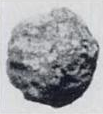Cast iron
Cast iron is a group of iron-carbon alloys with a carbon content greater than 2%. Its usefulness derives from its relatively low melting temperature. The alloy constituents affect its color when fractured: white cast iron has carbide impurities which allow cracks to pass straight through, while grey cast iron has graphite flakes which deflect a passing crack and initiate countless new cracks as the material breaks.
History[edit | edit source]
Cast iron has been used in China since the 5th century BC and in Europe since the 15th century. The earliest cast iron artifacts date to the 5th century BC, and were discovered by archaeologists in what is now Jiangsu in China. Cast iron was used in ancient China for warfare, agriculture, and architecture. During the Industrial Revolution, cast iron became a widely used material in construction, engineering, and manufacturing.
Types of Cast Iron[edit | edit source]
There are several types of cast iron, each with its own unique properties and applications:
- Gray cast iron: Contains graphite flakes, which give it a gray appearance and make it easy to machine. It is commonly used in engine blocks, pipes, and cookware.
- White cast iron: Contains carbide impurities, which make it hard and brittle. It is used in applications where wear resistance is important, such as in grinding and crushing equipment.
- Ductile iron: Also known as nodular cast iron, it contains nodules of graphite, which give it high strength and ductility. It is used in automotive components, pipes, and fittings.
- Malleable iron: Produced by heat treating white cast iron, it has improved ductility and toughness. It is used in hardware, fittings, and tools.
Properties[edit | edit source]
Cast iron is known for its excellent castability, wear resistance, and vibration damping. It has a high compressive strength but low tensile strength, making it suitable for applications where the material is subjected to compressive forces. The presence of graphite in cast iron provides good lubrication and thermal conductivity.
Applications[edit | edit source]
Cast iron is used in a wide range of applications, including:
- Construction: Used in the construction of buildings, bridges, and other structures.
- Automotive industry: Used in the manufacturing of engine blocks, cylinder heads, and other components.
- Cookware: Used in the production of cast iron cookware, such as skillets, Dutch ovens, and griddles.
- Pipes and fittings: Used in the production of pipes, fittings, and other plumbing components.
- Machinery: Used in the manufacturing of machine tool frames, bases, and other components.
Advantages and Disadvantages[edit | edit source]
Advantages[edit | edit source]
- High wear resistance
- Excellent castability
- Good vibration damping
- High compressive strength
Disadvantages[edit | edit source]
- Low tensile strength
- Brittle nature (especially in white cast iron)
- Susceptibility to corrosion
See also[edit | edit source]
References[edit | edit source]
External links[edit | edit source]
This article is a metallurgy-related stub. You can help WikiMD by expanding it!
Search WikiMD
Ad.Tired of being Overweight? Try W8MD's physician weight loss program.
Semaglutide (Ozempic / Wegovy and Tirzepatide (Mounjaro / Zepbound) available.
Advertise on WikiMD
|
WikiMD's Wellness Encyclopedia |
| Let Food Be Thy Medicine Medicine Thy Food - Hippocrates |
Translate this page: - East Asian
中文,
日本,
한국어,
South Asian
हिन्दी,
தமிழ்,
తెలుగు,
Urdu,
ಕನ್ನಡ,
Southeast Asian
Indonesian,
Vietnamese,
Thai,
မြန်မာဘာသာ,
বাংলা
European
español,
Deutsch,
français,
Greek,
português do Brasil,
polski,
română,
русский,
Nederlands,
norsk,
svenska,
suomi,
Italian
Middle Eastern & African
عربى,
Turkish,
Persian,
Hebrew,
Afrikaans,
isiZulu,
Kiswahili,
Other
Bulgarian,
Hungarian,
Czech,
Swedish,
മലയാളം,
मराठी,
ਪੰਜਾਬੀ,
ગુજરાતી,
Portuguese,
Ukrainian
Medical Disclaimer: WikiMD is not a substitute for professional medical advice. The information on WikiMD is provided as an information resource only, may be incorrect, outdated or misleading, and is not to be used or relied on for any diagnostic or treatment purposes. Please consult your health care provider before making any healthcare decisions or for guidance about a specific medical condition. WikiMD expressly disclaims responsibility, and shall have no liability, for any damages, loss, injury, or liability whatsoever suffered as a result of your reliance on the information contained in this site. By visiting this site you agree to the foregoing terms and conditions, which may from time to time be changed or supplemented by WikiMD. If you do not agree to the foregoing terms and conditions, you should not enter or use this site. See full disclaimer.
Credits:Most images are courtesy of Wikimedia commons, and templates, categories Wikipedia, licensed under CC BY SA or similar.
Contributors: Prab R. Tumpati, MD





